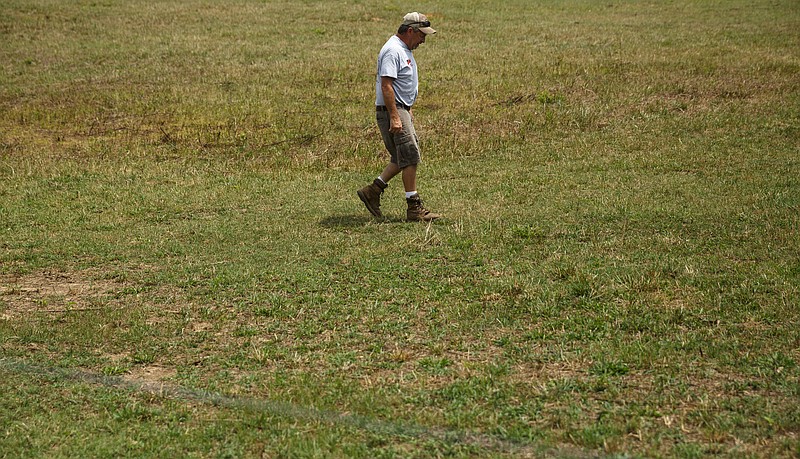Learn more
› What: Value and importance of planting of trees seminar› When: 10 a.m.-noon Saturday› Where: Hamilton County Extension Office, 6182 Adamson Circle› Cost: Free› Information: https://extension.tennessee.edu/hamilton/Pages/default.aspx
Gene Hyde is the city's forester and a man who knows plenty about caring for trees and shrubs.
He's also a self-described "amateur lawn manager" and, like the rest of us, he's dealing with a yard stressed by this past summer's brutal heat and drought.
His backyard is especially wounded.
"I lost probably 90 percent of my grass," he says. "It's been so hot and dry and back there is shady."
He plans to reseed his backyard soon, though he's not sure if he'll do it this weekend or next. First he'll aerate - poking holes throughout the yard to break up the soil and allow nutrients and what water there is to get to the roots. After that, he throw out a blend of 40 percent creeping red fescue, 40 percent tall fescue and the rest with annual rye.
After living in his house for 25 years, he says this is as bad as his lawn has ever been, but reseeding is more cost-effective than trying to save what's left. Still, he's undecided about when to reseed because there's no serious amount of rain - say an all-day storm - in the immediate forecast.
"If I put it down too soon, I'll have to do a lot of watering. If I wait too long, I could lose what I plant," he says.
But he has at least one possible solution.
"I'm going to water it and then I'm going to do a rain dance."
From May 26 through Sept. 19, the Chattanooga area had 96 straight days that were 90 degrees or hotter, breaking a streak set in 1954. The hottest was 100 degrees on July 21 and the area is currently in "exceptional drought" conditions, the worst level on the U.S. Drought Monitor. Weather.com has Chattanooga at No. 2 on its list of the five worst cities in the country this summer when it comes to weather.
Teresa Manning, office manager at Grass Is Greener landscaping on Cummings Highway, says she aerated and threw down new seed on her lawn in August. She turned on the sprinkler "and now it looks really nice."
"We have been watering a lot," she admits. Doubling the amount of time she watered daily from about 15 minutes to 30 has nearly doubled her water bill, she adds.
"In the environment we have now, you have to make a decision and do something," she says. "You can't let nature do it."
University of Tennessee-Hamilton County Extension Agent Tom Stebbins says the good news is that cooler temps, especially at night, are helping relieve some of the lawn stress. But we might have until the first of December to put down new seed, he adds.
"The cool weather has been a big blessing," he says. "People should definitely analyze their lawns before doing anything, but the fall is the time to these renovation-type things."
In addition to getting the soil tested to make sure it's at the optimum pH level for grass growing, Stebbins says you should take a good look at what is actually growing now. Lawns in this area are not designed to deal with more than 100 days of daytime temperatures in the 90s and very little rain, he says. So if your yard is 50 percent weeds or worse, tearing it all out and starting over is the best route, he says.
But first get rid of the weeds, he says, either with chemicals and/or tilling them up. Also, check to see how much actual topsoil you have, he says. Three to six inches is recommended. If you're going to do significant renovation work, putting down a couple of inches of new dirt might be a good idea, Stebbins says, because even one inch on top of the existing grass could help since new grass will grow through it.
Both Stebbins and Hyde say we are past the time to put down Bermuda seeds, but it's the right time for fescue, especially a blend specifically designed for this region.
So after all the tilling, seeding and watering is done, then what?
"Pray for rain. Rain is going to make a difference," Stebbins says.
If you do water, he says, it's better to water heavily - about two inches - once a week than to water less every day.
"You don't want to water every day or even every other day," he says. "People who watered daily over the summer might have done more harm than good. The grass doesn't want to grow when it's over 90 degrees during the day and not much cooler at night.
"You want to simulate a soaking rain."
And, to keep the grass healthy in the future, now is a good time to plant trees, he says.
"Trees are the backbone of our lawns. Properly placed trees provide shade and protect the lawn."
Contact Barry Courter at bcourter@timesfreepress.com or 423-757-6354.
